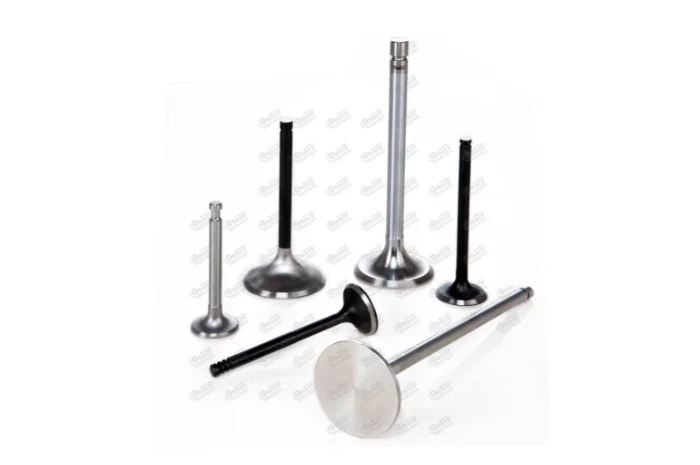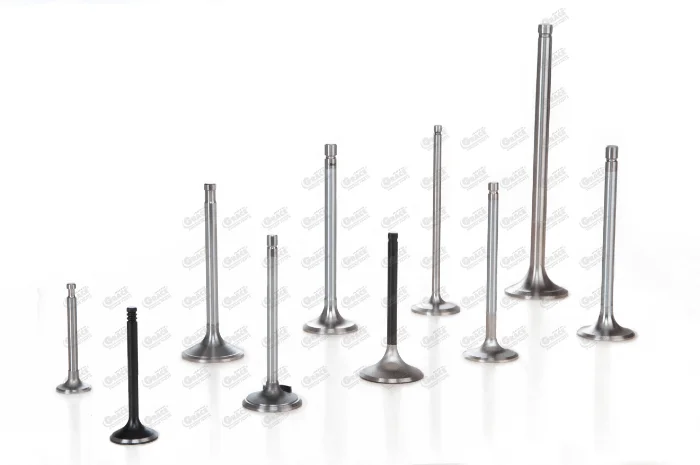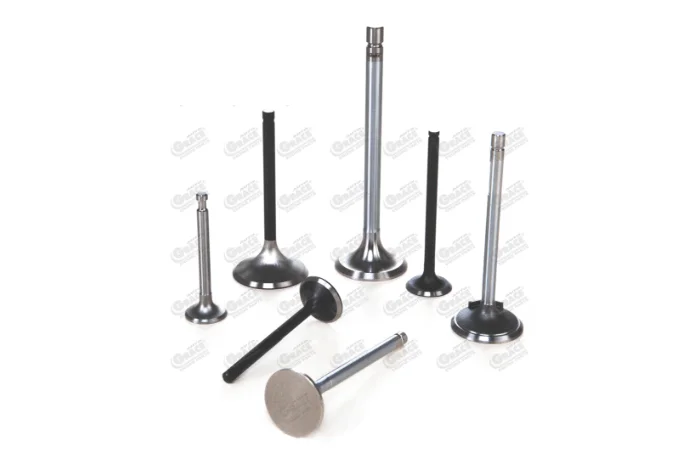Are you a distributor or importer?



Trustworthy Gatekeepers of the Engine
Over the life of an average engine, valves will open and close 300 million times, which places heavy demand on the fatigue strength and reliability of the valves.
Over the life of an average engine, valves will open and close 300 million times, which places heavy demand on the fatigue strength and reliability of the valves.
Garima Global is one of the few companies specialized in developing custom
made engine valves as per the requirements of our highly demanding customers.
Size Range of Engine Valves in AutoGRACE® Brand
| SPECIFICATION | FROM | TO |
|---|---|---|
| Stem Dia (mm) | 4.5 | 45 |
| Head Dia (mm) | 15 | 250 |
| Total Length (mm) | 50 | 1000 |
Garima Global supplies components for a wide variety of on-road, off-road, industrial and stationary applications such as: automotive (light duty) and light commercial, trucks (heavy duty), tractors (agricultural), earthmoving and construction machinery, generators, irrigation pumps, and defence / special purpose vehicles.
The brands for which we manufacture and export aftermarket products are Caterpillar, Chevrolet, Chrysler, Citroen, Cummins, Daewoo, DAF, Daihatsu, Detroit Diesel, Deutz, Fiat, Ford, Hino, Honda, Hyundai, International, Isuzu, Iveco, John Deere, Kamaz, Kia, Komatsu, Kubota, Land Rover, Leyland, Lister Petter, Lombardini, Mack, Mahindra, MAN, Massey Ferguson, Mazda, Mercedes Benz, Mitsubishi, Navistar, Nissan, Onan, Perkins, Peugeot, Renault, Scania, Suzuki, Tata, Tatra, Toyota, Ursus, UTB, Volvo, Yanmar and Zetor, amongst others.
Garima Global also export parts for air-brake compressors like Wabco, Bendix, Knorr, Cummins, Clayton Dewandre, Mercedes, Midland etc.
Garima Global has developed an extensive range of components for engine, braking, transmission, suspension, steering, chassis, electrical, lighting and other automotive sub-systems. To assist our customers with choosing the right product for their requirements we have published comprehensive catalogs with engine / vehicle models, interchange with references of OEMs and other popular aftermarket brands, fitment dimensions and other technical data. We strongly encourage you to contact us with your specific requirements so that we can email you the relevant catalogs, and we look forward to starting a mutually beneficial business relationship with you soon!
Fundamentally engine valves may be classified based on their function, design and material.
Control the flow of incoming air+fuel mix (gasoline engines) / air (diesel engines) into the power cylinder. Not subjected to extreme thermal loads due to cooling effect of incoming gases. Are usually larger in diameter than exhaust valves to allow more air to enter the combustion chamber, and also because the fluids passing through them are at a lower pressure.
Let the post-combustion exhaust gases out of the power cylinder, hence are subject to extreme thermal loads and corrosive chemicals. Are usually smaller than inlet valves since the gases are under high pressure and hence do not need as large an opening to escape out of the engine. However, they tend to be made of more expensive materials like non-magnetic steels, or coatings to harden their seating face to cope with their more demanding function.
Most valves have a solid monometallic or bi-metallic stem of steel grades mentioned in the MATERIALS section below, depending on their function and application.
Mostly bi-metallic with stem of EN52 and head of 21-4N grade steels, but there exist mono-metallic versions too. The stem is hollowed out to about 60% of the outer diameter, to reduce weight, and filled with liquid sodium which is agitated inside the stem cavity due to the rapid reciprocating motion of the valve. This conducts heat away from the head toward the stem. Used mostly in high-performance engines because of the extra cost involved in manufacturing.
The valve stem has a slight taper on the outer diameter to counter the temperature gradient during operation and prevent valve sticking. To avoid excess heat from reaching the valve stem seals, the stem cavity is terminated at least 10 mm away from the stem tip. Variants, in increasing order of performance and manufacturing complexity are:
Head is drilled from stem end and friction welded to a solid stem which is made of a hardenable alloy.
Similar to the above type, but the bore is closed off by inductive heating and forging.
Drilled from head end to reduce weight even further by hollowing out a larger portion of the head. The cavity is then sealed using a capping plate and a special process.
Ferritic-Martensitic steels like EN52 / X45CrSi93 are cost effective and sufficient for inlet valves and monometallic exhaust valves used in slower, low-performance engines. X85CrMoV18-2 is used for intake valves of higher performance engines where thermal / mechanical loads may not permit Cr-Si material. For intake valves, wear resistance is more important than thermal or corrosion resistance, hence martensitic steels are appropriate for them.
Non-magnetic Austenitic Cr-Mn steels like X53CrMnNiN21-9 (21-4N) are the cost effective choice for the valve head, which is welded to a stem made of X45CrSi93 or X85CrMoV18-2 steel. Ni-based Superalloys like INCONEL®-751 and NIMONIC®-80A are used where Cr-Mn steels cannot satisfy the operational reliability required, for example, in racing, aviation and heavily turbocharged diesel engines. Martensitic stem can be hardened to withstand the fatigue load on the tip of the valve while the austenitic or superalloy head portion has high thermal and corrosion resistance.
CHEMICAL COMPOSITION
| ELEMENT | X45CrSi93 X45CrSi3 X50Cr9Si93 1.4718 EN52 HNV3 SUH 1 |
X85CrMoV18-2 1.4748 |
X53CrMnNiN21-9 X55Cr22Mn9Ni4N 1.4871 21-4N EV8 SUH 35 |
INCONEL®-751 | NOMONIC®-80A |
|---|---|---|---|---|---|
| Carbon (%) | 0.40-0.50 | 0.80-0.90 | 0.48-0.58 | 0.10 MAX | 0.10 MAX |
| Silicon (%) | 2.75-3.75 | 1.00 MAX | 0.25 | 0.50 MAX | 1.00 MAX |
| Manganese (%) | 0.80 MAX | 1.50 MAX | 8.00-10.00 | 1.00 MAX | 1.00 MAX |
| Phosphorus (%) | 0.040 MAX | 0.040 MAX | 0.050 MAX | - | - |
| Sulphur (%) | 0.030 MAX | 0.030 MAX | 0.030 MAX | 0.01 MAX | 0.015 MAX |
| Chromium (%) | 7.50-9.50 | 16.50-18.50 | 20.00-22.00 | 14.00-17.00 | 18.00-21.00 |
| Molybdenum (%) | - | 2.00-2.50 | - | - | - |
| Nickel (%) | 0.50 MAX | - | 3.25-4.50 | (+Co) 70.0 MIN | BAL |
| Nitrogen (%) | - | - | 0.35-0.50 | - | - |
| Vanadium (%) | - | 0.30-0.60 | - | - | - |
| Iron (%) | - | - | - | 5.00-9.00 | 3.00 MAX |
| Titanium (%) | - | - | - | 2.00-2.60 | 1.80-2.70 |
| Aluminum (%) | - | - | - | 0.90-1.50 | 1.00-1.80 |
| Niobium + Tantalum (%) |
- | - | - | 0.70-1.20 | - |
| Copper (%) | - | - | - | 0.50 MAX | 0.20 MAX |
| Cobalt (%) | - | - | - | - | 2.00 MAX |
| Boron (%) | - | - | - | - | 0.008 MAX |
| Zirconium (%) | - | - | - | - | 0.15 MAX |
Other frequently used valve materials:
AutoGRACE® valves are manufactured by leading OEM and OES manufacturers across India that adhere to the highest quality specifications. In general the process involves first manufacturing the blank which is then precisely machined to obtain the fitment and functional tolerances. Lastly, special coatings may be applied to increases resistance to wear, corrosion, fatigue etc.
Engine valve blanks may be manufactured by the following processes.
A round bar of diameter slightly bigger than the finished stem diameter is heated and then reformed at one end to form a pear-shaped lump that is then machined into the head of the valve. This is the preferred and most cost effective method of valve production due to minimal wastage of material.
A round bar of diameter 2/3 of the final head diameter is heated and reformed to make a blank in two forging steps. The length of the bar has to be calculated according to the desired volume of the blank.
The valve head is formed by either of the above processes using a higher grade of austenitic steel which is then friction welded to a stem, which is simply a round bar, of lower grade but cost effective martensitic steel, thus achieving the ideal combination of materials required for stem and head in a single valve.
These steels loose strength and hardness at elevated temperatures but can be hardened to 35-55 HRC, hence are the material of choice for the stem because the tip of the stem needs to be fatigue and wear resistant against the constant tapping of the valve tappet.
These steels are resistant to thermal loads and corrosion but not very hardenable. Limited efficacy in seat hardening may be achieved by a closely controlled processes. Please see topics of interest below to see the details of heat treatment processes.
Zones prone to wear, like the tip of the stem and the seat of the head are induction hardened. Valve keeper grooves may also be case hardened or through hardened.
AutoGRACE® engine valves are manufactured on completely robotized lines especially for large production runs by leading manufacturers of engine valves in India. For smaller production runs the valves are sourced from semi-automated manufacturers who follow stringent quality systems like IATF or ISO and can provide the most cost effective solutions at adequate quality levels.
A combination of CNC machines, Special Purpose Machines (SPMs), Upsetters, Material Handling Robots, Centerless Grinders, Automatic Seat Grinders, Forging Lines, Induction Heaters and Surface Coating Plants all available in-house are used to produce these highly precise engine components.
Stem of the valve that reciprocates inside the guide is chrome plated to make it wear resistant. Plating is 3-15 μm thick.
Nitrogen is diffused into the surface of the valve, forming a highly wear resistant layer of iron-nitride 10-30 μm thick. Since this is not a plating but rather a diffusion process, there is no risk of the protective layer being stripped away due to scuffing or abrasion.
A wafer of hardened, wear-resistant tip is welded onto the valve. This is similar to a bimetallic valve but the hardenable martensitic tip is much smaller in length than a typical bimetal valve.
In especially heavy duty or high performance engines, a groove is machined into the tip or the seating ring of the valve. Stellite™ is then deposited into this groove which is then machined to achieve the required shape / dimensions. Stellite™ is a non-magnetic cobalt alloy that retains wear resistance and hardness even at elevated temperatures. Popular grades of Stellite™ suitable for valves are mentioned below:
CHEMICAL COMPOSITION
| ELEMENT | STELLITE™ 1 R30001 (SF)A 5.21 ERCoCR-C |
STELLITE™ 6 R30006 (SF)A 5.21 ERCoCR-A |
STELLITE™ 12 R30012 (SF)A 5.21 ERCoCR-B |
|---|---|---|---|
| Cobalt (%) | BAL | BAL | BAL |
| Chromium (%) | 32 | 30 | 30 |
| Tungsten (%) | 12 | 4-5 | 8 |
| Carbon (%) | 2.45 | 1.2 | 1.55 |
| Nickel (%) | 3.0 MAX | 3.0 MAX | 3.0 MAX |
| Molybdenum (%) | 1.0 MAX | 1.0 MAX | 1.0 MAX |
| Iron (%) | 3.0 MAX | 3.0 MAX | 3.0 MAX |
| Silicon (%) | 2.0 MAX | 2.0 MAX | 2.0 MAX |
| HARDNESS (HRC) | 51-56 | 40-45 | 46-51 |
Post any surface treatment grinding process is used to achieve surface finish (Ra < 0.2 on stem) by polishing the chrome nodules or nitride needles off the surface.
AutoGRACE® engine valves undergo stringent checks at our in-house lab before dispatch to our discerning customers globally on the following important parameters, among others. Garima Global has in-house Mitutoyo® Roundness Tester and Contracer to test all critical geometrical parameters of the valves. Our lab is also equipped with spectrometer, microscope, hardness tester, surface roughness tester etc. to rest the material and surface characteristics of these components.
Start the
conversation.
Every beautiful relationship starts with a simple hello. So let’s chat. It might just be the start of something memorable.